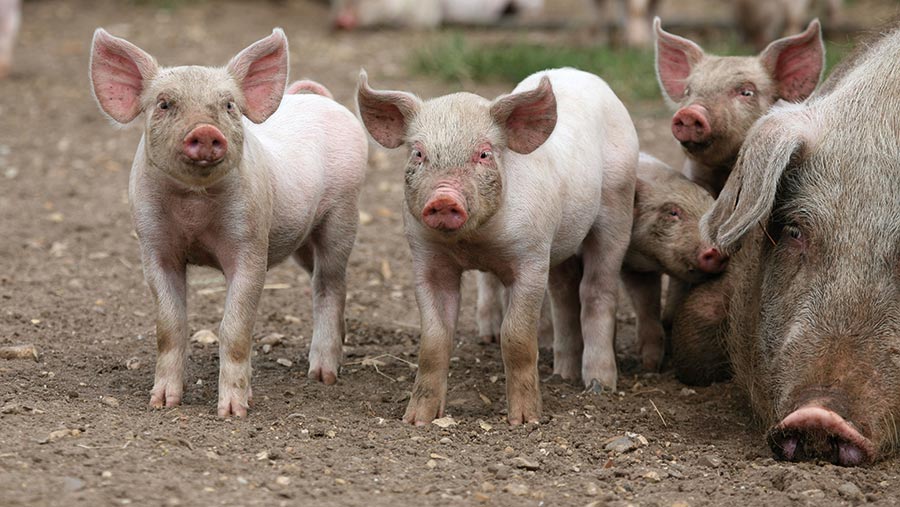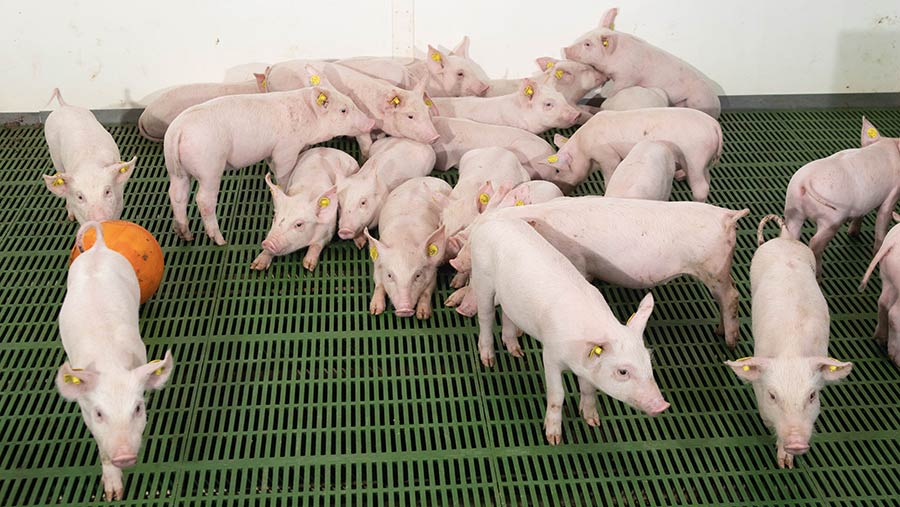Expert advice on zinc alternatives as ban in pig diets looms
 © Tim Scrivener
© Tim Scrivener Medicinal levels of zinc oxide in piglet diets have been used for many years to combat post-weaning diarrhoea.
However, certain products containing zinc oxide will lose their marketing authorisations in June 2022.
The EU announced the forthcoming removal of certain products in 2017, but details remain unconfirmed.
Producers are being advised to investigate alternatives now to find out what works for them and ensure as smooth a transition as possible.
The UK pig industry has been in discussions with the Veterinary Medicines Directorate (VMD) about the possibility of more flexibility being applied, given that modelling has shown that zinc oxide’s potential risk to the environment is lower in the UK than in wider Europe.
See also: What to consider before a switch to five-week pig weaning
National Pig Association (NPA) chief executive Zoe Davies says: “We will continue to lobby against a full ban.
However, there will almost certainly be some restrictions on using zinc from this summer.
“While we will be looking to ensure those most affected have the ability to access zinc, producers need to be looking at alternative options now, in preparation.”
Farmers Weekly asked Dr Davies, pig nutritionist Phil Baynes and vet Max Wood about some options producers can consider.
Holistic approach
There is no single solution to controlling post-weaning diarrhoea. A holistic approach to management is key to make sure piglets are as strong as possible ahead of, and during, the weaning process.
While some producers have removed zinc and seen no subsequent issues with post-weaning diarrhoea, others have had problems and have had to find other solutions.
In the longer term, it is advisable to review all aspects of management and see where improvements can be made, as when producers rose to the challenge of a reduction in antibiotics use.
But it is crucial for producers to trial changes and alternatives now, while zinc is still available as a back-up option to help control any diarrhoea problems.
Creep feeding
Creep feeding is an important part of controlling post-weaning diarrhoea. It is commonly practised on indoor units, with increasing numbers of outdoor producers also introducing it.
Pre-warming weaner accommodation helps to provide as comfortable an environment as possible.
Minimising all potential stressors around weaning also helps maintain gut health and gastric function, to ensure piglets make the most of available nutrients.
Dietary protein and fibre
Protein digestibility is the first area to focus on to minimise the risk of post-weaning scours. The aim is to increase the proportion of digestible protein in the diet to reduce the total amount of protein.
This, in turn, reduces the risk of undigested protein causing problems in the small intestine.
Pepsinogen is the main enzyme required for protein digestion. When it reacts with hydrochloric acid in the stomach it is converted to pepsin.
Piglets are not fully able to produce hydrochloric acid, so some raw protein can pass through to the small intestine.
Here it provides a food source for bacteria such as E coli, which is a common cause of post-weaning diarrhoea.
Hydrolysed soya will provide one suitable source of protein, as processing of the soya improves its overall digestibility.
Insect protein may also provide a good source of highly digestible protein in future – although uptake may be price-dependent.
Dietary fibre supply should also be checked and optimised. Fibre is important for maintaining the passage of digesta through the gut.
Fibre fermentation also produces volatile fatty acids which can benefit intestinal health, although this is mainly in older animals than the target post-weaning stage.

© Tim Scrivener
Water acidification
Many producers already use water acidification products for sterilisation of water lines.
Acidified water makes the environment within the piglet’s gut less hospitable for disease-causing bacteria. It also helps with conversion of pepsinogen to pepsin for protein digestion.
However, seek advice on which acidifier to use, as the wrong product for your situation can exacerbate a problem by killing certain bacteria and giving others the opportunity to proliferate in the water line.
This can lead to slime-mould and blocked drinkers, which can lead to dehydration and reduced feed intake.
If you are using oral vaccines, be aware that they cannot always be put in the water at the same time as acidifiers or other products.
Feed additives
Some nutritional products can contribute to overall nutritional management, although they are unlikely to provide a direct replacement for zinc.
These include prebiotics, which help promote beneficial bacteria, and probiotics, which are designed to help keep the gut microflora in balance.
Enzymes, organic acids and essential oils also have a role to play in dietary formulation. Consult your nutritionist about possible new options or adjustments.
Cleaning and disinfection
Cleaning and disinfecting rooms before newly weaned piglets go in is paramount in reducing disease pressure during the weaning period.
Take a fresh look at cleaning and disinfection protocols to make sure your process is as thorough as possible.
Make sure all the nooks and crannies are fully cleaned and disinfected, for example around feeders, where there is contact with pigs’ noses and mouths.
Ensure disinfectant is left in contact with surfaces for long enough to work effectively, and allow adequate time for pens to dry out properly – an important step that can be overlooked.
Vaccination
E coli-specific vaccines now exist which can help protect against issues such as bowel oedema as well as scour.
However, to make sure that investment in vaccines is worthwhile, take some faecal samples to identify the pathogens involved and ensure treatment is accurately targeted.
Not every vaccine is right for every farm, and vaccination is not a standalone solution; it needs to be part of a holistic management plan.
Again, now is the time to carry out sampling and build an understanding of any risks specific to your farm, while zinc oxide is still available.
Five-week weaning
Keeping piglets on the sow for an additional week is a way to produce a bigger, more robust pig with greater gut maturity, ready for weaning at five weeks old.
There are indoor and outdoor producers who are making this work, with some good post-weaning performance results.
It is logical that the system can also help reduce the risk of scour once zinc is removed from diets.
It is critical that optimum sow nutrition is maintained throughout lactation to support the sow’s body condition. This can be challenging even in a four-week weaning system.
Changes to infrastructure and timings also need to be considered, and the system may not be feasible on every farm.
